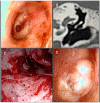Type 1 Tympanoplasty Outcomes between Cartilage and Temporal Fascia Grafts: A Long-Term Retrospective Study
- PMID: 36498572
- PMCID: PMC9740685
- DOI: 10.3390/jcm11237000
Type 1 Tympanoplasty Outcomes between Cartilage and Temporal Fascia Grafts: A Long-Term Retrospective Study
Abstract
Background: To compare the functional and anatomical results of two different types of grafts in type 1 tympanoplasty (TPL I). Methods: A retrospective comparative bicentric study was conducted on patients treated with TPL I using temporal fascia or tragal cartilage. We evaluated the functional and anatomical results with intergroup and intragroup analyses. Variables predicting long-term success were also evaluated. Results: A total of 142 patients (98 fascia graft vs. 44 cartilage) were initially assessed, with a mean follow-up of 67.1 ± 3.2 months. No significant differences were observed between the two groups on the intergroup analysis of age, gender, ear side, or pre-operative hearing data (all p > 0.05). At the intragroup analysis of auditory outcomes, both groups demonstrated a significant improvement in post-operative air conduction, with greater gain for the fascia group at 6 months follow-up (p < 0.001 for both); however, at long-term follow-up, cartilage demonstrated better stability results (p < 0.001). When comparing the pre-and post-operative air-bone-gap (ABG), both groups showed a significant gain (p < 0.001); the fascia group showed that at 6 months, a greater ABG increase was found, but the difference was not statistically significant (4.9 ± 0.9 dB vs. 5.3 ± 1.2 dB; p = 0.04). On the contrary, the cartilage group at long-term follow-up at 5 years maintained greater outcomes (10 ± 1.6 dB vs. 6.4 ± 2 dB; p < 0.001). Lower age (F = 4.591; p = 0.036) and higher size of perforation (F = 4.820; p = 0.030) were predictors of long-term functional success. Conclusions: The graft material selection should consider several factors influencing the surgical outcome. At long-term follow-up, the use of a cartilage graft could result in more stable audiological outcomes, especially in younger patients or in case of wider perforations.
Keywords: cartilage; fascia; graft; myringoplasty; perforation; tympanoplasty.
Conflict of interest statement
The authors declare no conflict of interest.
Figures



References
-
- Wullstein H. Funktionelle operationen im mittelohr mit hilfe des freien spaltlappen-transplantates. Archiv. für. Ohren-Nasen-und Kehlkopfheilkunde. 1952;161:422–435. doi: 10.1007/BF02129204. - DOI
LinkOut - more resources
Full Text Sources
Miscellaneous

